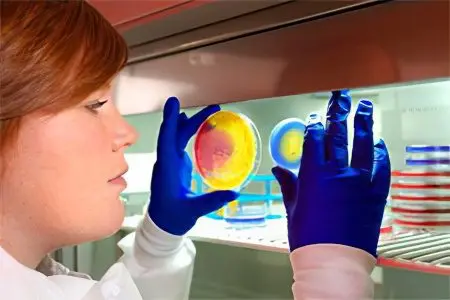Contents
Hemolytic Staphylococcus is a bacterium that causes infectious and inflammatory reactions in the human body. The hemolytic microorganism got its name because of its ability to hemolysis, that is, to destruction. Hemolytic staphylococcus is a conditionally pathogenic bacterium for humans, it is capable of causing various purulent processes.
The size of the bacterium can reach 1,3 microns, they settle in groups resembling a bunch of grapes. Most often it is found in the armpits, in the groin and in the perineum. A distinctive feature of hemolytic staphylococcus is their super-resistance to antibacterial drugs.
Symptoms of hemolytic staphylococcus aureus

As long as a person’s immunity is functioning properly, he should not worry about a staph infection.
However, as soon as the defense weakens, hemolytic staphylococcus begins to multiply actively and can lead to various diseases, including:
Damage to the upper respiratory tract is accompanied by the formation of a purulent plaque on the tonsils, purulent discharge from the nose, and pain in the affected area.
Lesions of the skin, accompanied by purulent inflammation, such as: the development of abscesses, boils, pustules.
Endocarditis, that is, an inflammatory reaction localized in the lining of the heart, can also be caused by hemolytic staphylococcus aureus.
Lesions of the urethra and cystitis, which is expressed in frequent urination, purulent discharge and the appearance of pain.
Damage to the respiratory organs, in particular the pleura and lungs, which is expressed in a cough with purulent sputum discharge, lack of air, blue lips, etc.
Lesions of the digestive system, with the inclusion in the process of the stomach and intestines. Characterized by the occurrence of local pain, diarrhea, vomiting, nausea, bloating.
Lesions of the brain and spinal cord, brain abscess.
Septic lesions, when all organ systems are included in the pathological process, since the infection spreads through the blood.
Damage to bone tissue and joints, which manifests itself in stiffness of movements, the occurrence of pain and redness of the skin in the area of inflammation.
In addition, each of the diseases, as a rule, is accompanied by an increase in body temperature, a decrease in working capacity, a lack of desire to eat, and drowsiness. These signs are the result of a general intoxication of the body.
Ways of infection with hemolytic staphylococcus aureus
For infection to occur, direct contact with the bacterium is necessary. The infection can be transmitted:
By airborne droplets, when a talking, coughing or sneezing person becomes a source of spread.
By contact, through any household items or even through handshakes. Of particular danger are people with open purulent wounds.
By food, that is, by consuming contaminated foods. Bacteria can get on food both from a sick animal and from a sick person.
Among the risk factors that increase the likelihood of infection, first of all, one can note the failure to comply with elementary hygiene skills. In addition, chronic diseases, weakened immunity, viral infections, uncontrolled intake of antibacterial agents, and dysbacteriosis contribute to infection.
Treatment of hemolytic staphylococcus aureus

Treatment must begin with the fact that the sensitivity of hemolytic staphylococcus to a particular drug will be established. If there is no time to wait for the results of the analysis, then, as a rule, therapy for a staphylococcal infection begins with the use of protected penicillins. It can be sulbactam, amoxicillin or clavulant. The choice of drugs determines the high resistance of bacteria to penicillin drugs. While the combination of ampicillin with clavulanic acid can help overcome this resistance.
After the result of the analysis for the sensitivity of hemolytic staphylococcus to antibiotics is obtained, it is possible to replace the previously selected agent. Among the most commonly used: macrolides, lincosamides, cephalosporins.
In addition, during treatment it is necessary to use symptomatic agents. So, to eliminate pain and reduce body temperature, non-steroidal anti-inflammatory drugs are prescribed. Depending on the location of the infection, it is possible to carry out local treatment, for example, gargling with antiseptic solutions, washing the nose, etc. Staphylococci are especially sensitive to chlorhexidine, chlorophyllipt, and furacilin.
If antibacterial agents are not able to cope with hemolytic staphylococcus, then it is possible to use a bacteriophage or toxoid acting against it.
In some cases, treatment is required not only for the active form of the bacterium, but also for the elimination of its carriage. For example, if we are talking about a pregnant woman. She is prescribed subcutaneous immunization with staphylococcal toxoid.
Prevention of hemolytic staphylococcus aureus
To prevent infection with hemolytic staphylococcus aureus and prevent the infection from spreading, the following preventive measures are advisable:
Timely detection of patients with hemolytic form of infection and adequate therapy;
Personal hygiene rules should not be ignored, which primarily come down to regular hand washing and the use of only your own care products;
Elimination of chronic foci of infection that contribute to a decrease in immunity;
Refusal of self-treatment with antibacterial agents;
Reception of vitamin and mineral complexes;
Frequent airing of rooms and wet cleaning, especially in places where a large number of people accumulate.









